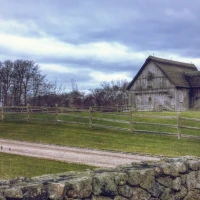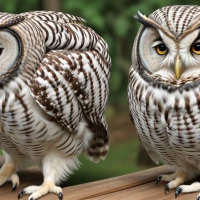The night is alive with whispers in the Buckeye State; a silent wingbeat here, a soft hoot there—that’s the mysterious world of Ohio’s majestic owls. This nocturnal raptor has long captivated the minds of bird enthusiasts and nature lovers alike, lurking in the shadows of dense woodlands or silently gliding across moonlit skies. In Ohio, the variety and charm of these creatures only add to the state’s rich biodiversity. As we pull back the veil on these enigmatic birds, join us in exploring the different species, their unique behaviors, and how to encounter these owls in Ohio.
Ohio, a state with a diverse temperature range, has become a haven for several owl species. Whether you’re an avid birdwatcher or a curious onlooker, there’s something utterly bewitching about spotting an owl in its natural habitat. So, let’s delve deeper into the nocturnal world and unearth the secrets of these remarkable birds of prey.
The Habitat and Habits of Ohio’s Owls
Recognizing the Habitats of Ohio’s Feathered Nocturnes
Ohio boasts a variety of landscapes that cater to the needs of different owl species. From the marshy wetlands to the dense forests, the state’s rich ecosystems provide perfect owl prowling grounds. Here are a few habitats where you might find these winged wonders:
- Deciduous forests: Home to Barred Owls and Great Horned Owls, towering trees offer nesting sites and ample hunting grounds.
- Coniferous forests: Preferred by the Northern Saw-whet Owl for its dense coverage and isolation.
- Wetlands and swamps: Attract Short-eared Owls, especially in the wintertime when they may roost in groups.
Learning about these habitats not only aids in the conservation efforts of owls but also enhances the likelihood of spotting one in the wild.
The Nocturnal Routines of Owls in Ohio
Owls are predominantly nocturnal, employing the cover of night to hunt and socialize. However, some species, like the Short-eared Owl, are also active during the twilight hours. Ohio’s owls engage in various nightly rituals:
- Stalking prey: Skilled hunters, they feed on a diet of rodents, insects, and smaller birds.
- Mating calls: These are especially vocal during the breeding season; each species has its distinct call.
- Nesting: Owls don’t typically build nests but will take over abandoned nests of other birds or utilize natural cavities.
Understanding these behaviors is essential for those hoping to witness owls in their natural setting.
Species of Owls in Ohio: A Look at the Residents
The Majestic Great Horned Owl: Ohio’s Formidable Predator
Topping the list of Ohio’s most impressive owls, the Great Horned Owl is both awe-inspiring and intimidating. Here’s what makes this bird a standout:
- Appearance: Notable for its tufted “horns” and deep hooting voice.
- Hunting prowess: Its powerful talons and keen eyesight make it a dominant hunter.
The Elusive Barred Owl: The Forest Phantom
Barred Owls are less conspicuous but equally fascinating:
- Markings: Striped plumage that helps it blend into the woodland shadows.
- Vocalizations: Distinctive “Who cooks for you?” call that echoes through the trees.
Eastern Screech Owl: The Pint-Sized Predator
Though small in stature, the Eastern Screech Owl holds its own:
- Variety: Exhibits a range of colors, from gray to a rufous red.
- Survival: Adapts well to human proximity, often found in suburban areas.
The Long-eared Owl: The Silent Hunter
A master of stealth, the Long-eared Owl is a sight to behold:
- Roosting habits: Prefers dense foliage, making it challenging to spot.
- Communal roosting: In winter, may roost in groups for warmth and safety.
With these species descriptions and more, aspiring owl observers can better distinguish between the various owls that call Ohio home.
Best Practices for Owling in Ohio: How to Safely and Ethically Observe Owls
Ethical Viewing: Respecting Ohio’s Nocturnal Beauties
To maintain the well-being of owls in Ohio, it’s crucial to observe some ground rules:
- Minimize disturbances: Keep noise levels down and movements slow to avoid startling these sensitive birds.
- Use of light: If using a flashlight, ensure it’s red-filtered to minimize the impact on the owls’ night vision.
- Observation distance: Maintain a respectful distance to prevent stressing the owls.
Tools of the Trade: Equipment for a Successful Owling Expedition
Equipped with the right gear, you can enrich your owling experience:
- Quality binoculars or a spotting scope: Essential for clear, detailed viewing.
- Field guides and apps: Help with identification and understanding behaviors.
- Recording devices: For the avid birder, capturing calls can aid in species identification.
By following these practices and being equipped, owl enthusiasts can enjoy these magnificent birds without causing harm.
Conservation Efforts: Protecting the Future of Ohio’s Owls
Understanding the Threats to Owl Populations
Several factors contribute to the decline of owls in Ohio. Habitat loss, rodenticide use, and collisions with vehicles are significant threats to their survival. Educating oneself about these perils is the first step toward effective conservation.
Supporting Local Conservation Initiatives
Numerous organizations in Ohio work tirelessly to protect owl habitats and advocate for policies that benefit these birds. Supporting these efforts, whether through volunteering time or donating funds, is vital to ensuring a protected future for Ohio’s night hunters.
Encounter the Nocturnal Majesty: Owl Spotting Hotspots in Ohio
For anyone eager to observe these elusive birds, Ohio offers several prime locations known for owl activity. Checking out state parks, nature reserves, and even certain urban areas could yield an unforgettable encounter with owls in Ohio.
- Hocking Hills State Park: Offers dense forests where Great Horned Owls reign supreme.
- Magee Marsh Wildlife Area: A sanctuary for migrating owls and a haven for Short-eared Owls.
- Cuyahoga Valley National Park: Diverse habitats attract a range of owl species, including Barred Owls.
The exploration of these hotspots allows bird watchers to immerse themselves in the habitat of these fascinating creatures.
Uncovering the Owls of Ohio: Tips and Tricks for Identification
Mastering the Art of Owl Identification
Identifying owls in Ohio involves a combination of visual markers and auditory cues. Learning the different calls and physical characteristics of each species increases the chances of correctly identifying the owls you encounter.
Keeping a Record: Document Your Owling Experiences
Maintaining a birding journal or an online record of your sightings not only contributes to citizen science efforts but also enhances your skills as an owl observer.
Conclusion: Embrace the Enchantment of Ohio’s Nocturnal Aviators
The quest to discover and understand Owls in Ohio takes patience, respect, and a keen sense of curiosity. By venturing into their mystical nocturnal world, we not only enrich our appreciation for nature’s wonders but also become stewards for these mesmerizing birds of the night. Whether you’re gazing through binoculars or simply enjoying the solemn hoots on a moonlit evening, remember that every encounter with these majestic creatures is a privilege and a gift.










